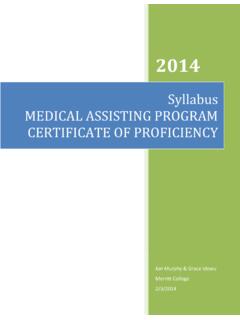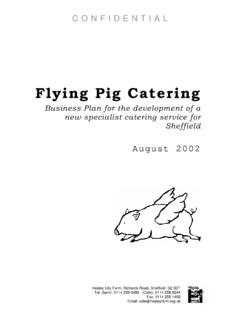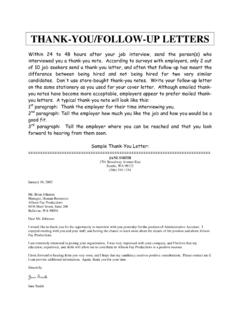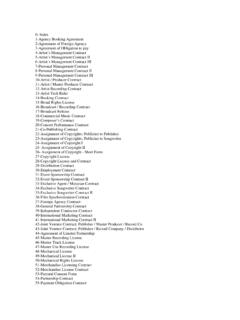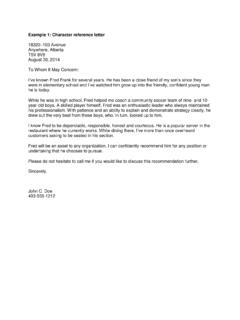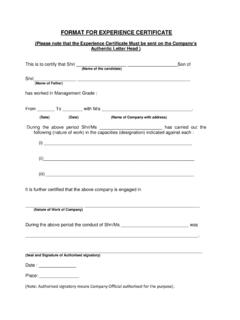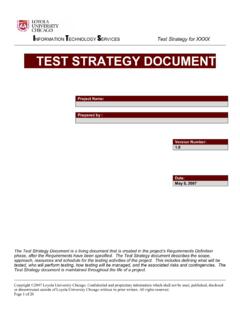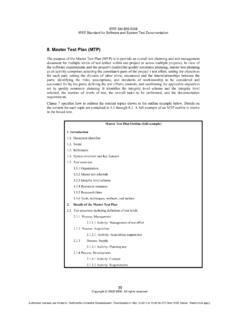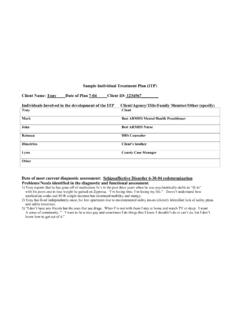Transcription of TITLE (TIMES NEW ROMAN, 12, BOLD)
1 AN EXAMPLE FORMAT FOR DESIGN PROJECT REPORTS [ADAPTED FROM ASME GUIDELINES FOR STUDENT DESIGN COMPETITION] TITLE (TIMES NEW ROMAN, 12, BOLD) Team Name (Times New Roman, 12) First Author (Times New Roman, 12) Second Author (Times New Roman, 12) Third Author (Times New Roman, 12) ..continue to list all authors / team members Date (Times New Roman, 12) Abstract (Times New Roman, 12, justified, placed on TITLE page) The report should start with an abstract of approximately 100 words, summarizing the objective, contents, results, and conclusions of the report as specifically as possible. The heading of the Abstract should be italic. Update the abstract as more sections of the report are competed. [Note: The purpose of the design report is to describe and justify the final design (or for the intermediate reports the current status of the design).]
2 The audience is primarily decision makers ( technical and business project managers) in your company and internal technical staff. The style (based on guidelines in Style guide [Shipley and Associates, 1987] and Write to the Top [DiGregorio, 1995] should follow these guidelines: 1) Take the active voice (use first person nouns and direct, forceful verbs); 2) Use pronouns when recommending something, drawing conclusions, or conveying decisions; 3) Write the way you talk - make it easy for the reader to get your point; 4) Keep most sentences and paragraphs short. Formatting Guidelines: The entire body text of the report should be Times New Roman, 12, with 1 inch margins. Major headings should be numbered consecutively, , , , etc, typed in bold face with a font size of 16.
3 Sub-headings should be numbered consecutively, , , etc, typed in bold face with a font size of 14. Finally, sub-sub-headings should also be numbered consecutively, , , etc., typed in bold face with a size 12 font face. It is not recommended to go beyond three levels of headings. Introduction (Times New Roman 16, Bold, left) Use the introduction section to provide some background information on the overall design problem domain. This introductory information should come from your literature search Library, Internet, trade magazines, etc. Key points to cover: Set the context: Help the reader understand general information about the problem or need area, including any necessary definitions, statistics, etc. Use pictures and visual images as much as possible.
4 Explain the purpose: why is this work important? Set the scope: How far can you or will you go to solve the problem? State the objectives: In short statements or a bullet list, identify the specific objectives of your work - things that can be assessed at the end of the project to determine if you were successful. Important Note: All sources that are not your own ideas must be referenced. For your reports, please use the parenthetical references: author-date system. A sample reference list addressing each of the five main types of information sources is given at end. These include: websites (Swanson, 1999), journals (Muriru and Daewoo, 2002), books (Zacharia and Daudi, 2001), conference proceedings (Peters et al., 2001) and patents (Wen-Cheng, 1994). For more information on ethical standards for publications (for the example of ASME journals), see # Initial Needs Statement (Times New Roman, 14, left) Provide a brief paragraph describing the initial needs statement the needs statement itself is usually given to the design team.
5 Please also include some initial discussion of the need statement, linked to the introductory material. Customer Needs Assessment This section describes the iterative FOCUS process for defining the customer (360 degree perspective), developing appropriate interview and observation guides, collecting data, and converting it to customer requirements statements (customer needs). Please show/describe the iterative nature of the process to illustrate how the project was impacted by customer input. This section should include descriptive text and several tables and figures, including: 1. An initial customer needs list obtained from interviews and observations (refer to Table 1). Note that all table captions are placed on top of the tables. Please note that all tables are numbered consecutively.
6 Please make sure that a table is not split between two pages. Move the table to a location where it can fit. If the table is too big to fit, split the table into two separate tables. 2. A table listing the hierarchal design objective list, that has been augmented with constraints and functions (refer to Table 2). Note that the constraints and functions are formatted differently for easy identification. 3. Include the most relevant copy of your interview guide and observation guide in the Appendix, and reference it from this section. 2 Table 1. Initial Customer Needs List Obtained from Interviews and Observations (Times New Roman, 12, Bold, Centered) 3 Table 2. Hierarchal Customer Needs List (With Weighting factors) (Times New Roman, 12, Bold, Centered) Weighting of Customer Needs This section should begin with a brief introduction on the importance of weighting, and then provide a description and/or tables that show how the weights were calculated.
7 The resources for making decisions discussed in class would be a good tool to use here. Figure 1 illustrates the use of one method, the Analytical Hierarchy Process (AHP), to create a weighted hierarchal customer needs list. It is very important to include figures and tables to show how the decisions were made, not just what the decisions are. Like tables, all figures are numbered consecutively. Unlike tables, however, figure captions are typically placed at the bottom of the figure. This section should build on and make reference to the weighted hierarchal customer needs list. 4 Portable User Fr. Flexible Durable Total Weighting Portable User Fl. Flexible Durable Figure 1.
8 Example of AHP Pair wise Comparison Chart to Determine Weighting for Main Objective Categories Revised Needs Statement and Target Specifications Using the initial problem statement and the knowledge gathered from the customer needs, describe a revised needs statement that provides a more concise description of the design problem. Clearly define the target specifications and the design criteria that define the problem (generated from the customer requirements and engineering standards). Include the initial justification for the specifications and the metrics (how meeting the specs will be measured), referring to customer requirements and benchmarking results as appropriate. Also describe how the specifications were checked with the customer to ensure they meet their needs.
9 External Search This section should include information gathered from numerous sources about the design problem and the product, process, or system that is at the center of the design problem. Focus primarily on the information that is pertinent to the revised needs statement and target specifications. Sources should include library, internet, magazines, patents, observations of actual products, discussions with experts , etc. You should also perform a patent search to determine the key technologies used in similar designs. Focus on utility patents (looking at function) and not cosmetic patents (focusing on artistic design). Evaluate the patents and information sources, and clearly state what impact they have on the development of your project.
10 Also, summarize your business opportunity, and make reference to your "Business Opportunity Statement" in the Appendix. Benchmarking This section should identify all commercially available products, processes, or systems that attempt to address all or a significant part of the needs statement that your project is addressing. Create a benchmarking table that compares numerous applicable features. Note that not all 5systems will have all features. The results should be prefaced with an introductory paragraph and then neatly summarized in a table (see Table 4). In tables, you may reduce the font size to 10 point to allow inclusion of more information per table. Recall a single table should not be split over multiple pages. This section might also include: 1.
